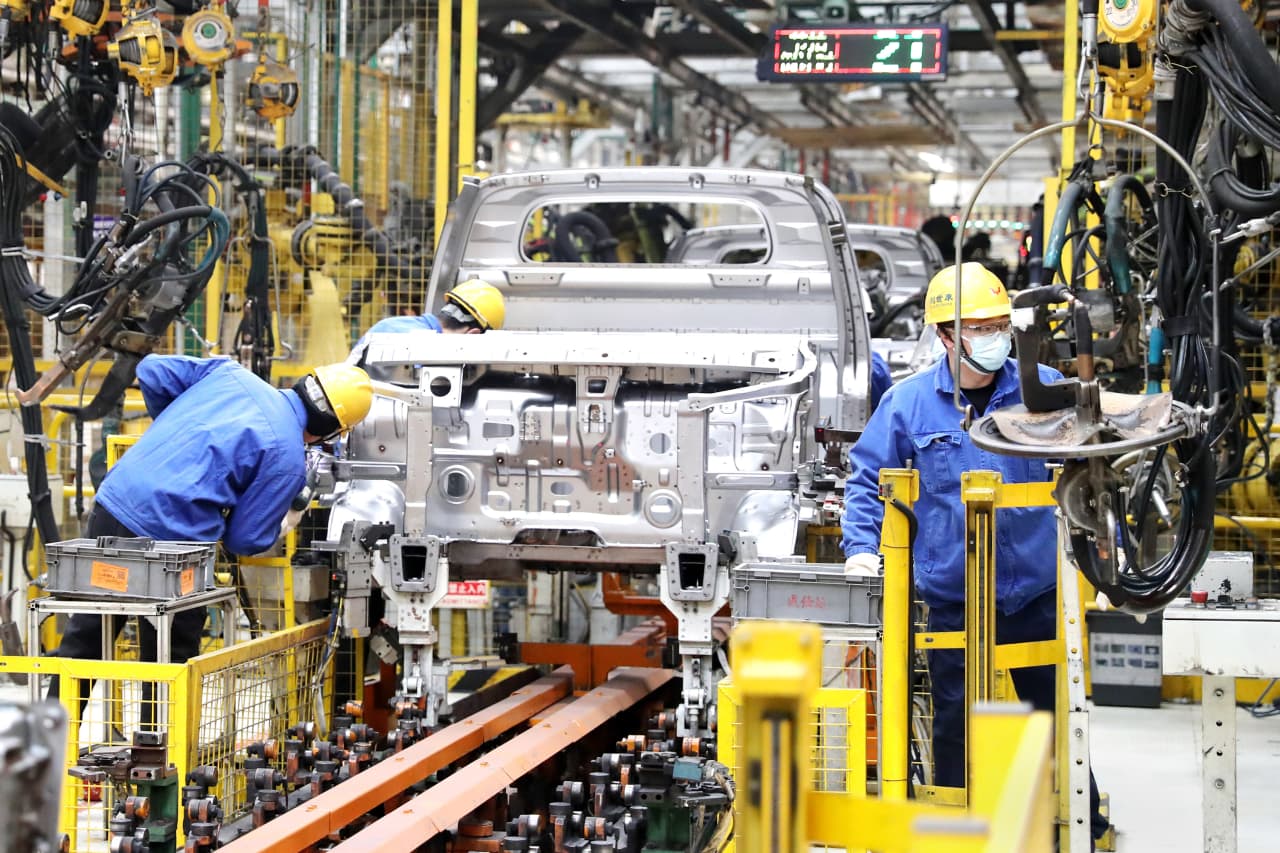Jay Buys’s wife changed his life with 10 words: “You know, you don’t have to just wear band T-shirts.”
Shirts from Nine Inch Nails and Thrice—for years, this was the bulk of Buys’s wardrobe. Were they awesome ? Yes. Did they make him look like the CEO of a successful web design firm? Not quite. “If I looked better, I would’ve felt better,” said Buys, 44, of San Diego. So he hired someone to teach him to look better.
For most, the term “stylist” brings to mind a celebrity dresser putting Timothée Chalamet in a bombastic red carpet outfit. But there is also an industry of white-collar stylists helping hapless corporate types find the right shirts and trousers for their daily lives.
For Buys, that guy was Patrick Kenger.
Kenger runs Pivot, a personal styling service, charging as much as $5,000 to remake your wardrobe. Kenger’s job is part Marie Kondo, part therapist and large part a personal shopper. He helped Buys retire the band tees at work, subbing them with Suitsupply blazers and Bonobos trousers.
The switch had a Superman-bursting-out-of-the-phone-booth effect on Buys. “I look like I know what I’m doing.” Strangers seem to think so, too. He was startled when a random 20-something at the grocery store saw his leather John Varvatos jacket and chirped, “I like your drip, bro!”
Today, strivers in tech, law and finance are wealthier than ever, but corporate dress codes have collapsed. The hoodie-clad billionaire has become a cliché. In the C-suite, Loro Piana sneakers have trounced dress shoes. Fleece vests have vanquished ties. At the same time, we’re in a new era of boardroom boasting.
Executives crow about their pay packages, their workout routines (looking at you Mark Zuckerberg!) and the rarity of their sneakers. To look like you haven’t bought new clothes since we all clutched BlackBerrys is to risk being lapped on the corporate ladder.
So, if you’re sitting there confidently dressed and accepting compliments on how well your pants fit, congrats! But there are many men who lack the skills to piece an outfit together. Stylists say their work has ballooned in the past decade as the range of options on what’s office “appropriate” has waylaid even confident corporate leaders.
“Men are very confused right now with the dress codes that have blurred the lines of formality,” said Jacci Jaye, a white-collar stylist in New York City for two decades, whose services start at $3,800 plus expenses. Jaye, who works solely with executives, said that many of her roughly 50 clients knew what they liked in terms of style, but had no idea how to achieve that look.
“I looked sloppy and I didn’t want to look sloppy,” said Raj Nangunoori, 36, a neurosurgeon in Austin. He spent working hours in scrubs, but out of them, he was adrift. “Even shorts, like I was never great at picking out shorts,” Nangunoori said.
Around a year ago, he googled in search of a stylist and hired Peter Nguyen, a former menswear designer turned $10,000 stylist. Nguyen’s entrepreneur- and tech-type clients are long on money, short on time and scant on clothing knowledge.
Nguyen’s first step is a lengthy questionnaire: What music do you listen to, what are your hobbies, where do you vacation? “I view my clients like they’re characters in a movie,” he said. They give him their background and Nguyen’s job is to outfit that character.
The pair landed on a neat framework for Nangunoori’s new look: What would Ryan Reynolds wear? Prosaic tees were swapped for polo-neck sweaters and James Perse chinos were tailored to fit properly. Nguyen got Nangunoori into a pair of Common Projects minimalist $500-ish sneakers. Most importantly, he convinced him to ditch his shopping mistake paint-splattered jeans.
“I can’t pull off what Travis Scott’s wearing,” said Nangunoori, relaying all his hard-bought wisdom.
Like working with a trainer, some clients are wary of admitting they enlisted a fashion guru. One CEO I spoke with who hired a stylist told his business partner he had done so, only to be mocked. After that, he decided “I’m not talking to anyone.”
“I never had my own confidence in going shopping and buying suits or dress clothes or even my weekend stuff,” said Nate Dudek, 42, an executive at a software company living in East Hampton, Conn. A “technology nerd,” Dudek wasn’t born with a strong visual sense. “That goes from everything from picking a wall color in my house to the way I dress.” His tees-and-jeans wardrobe was as spicy as a glass of milk.
In 2022, about one year before co-founding his own company, Dudek “set out to invest in myself” by hiring Cassandra Sethi, a New York stylist behind the company Next Level Wardrobe whose services currently start at $5,500. Dudek’s wife, who has “killer style” and occasionally shopped for him, took some warming up to the idea. “She was like, ‘Why? I’m so good at buying you clothes!’”
But Dudek wanted an objective outside advisor—someone who didn’t know him as intimately as his wife—to overhaul his closet. (His wife has come around, and is relieved to not be his unpaid personal shopper.)
He never even had to meet her in person. Sethi shipped him boxes of clothes and over a three-hour Zoom session they deduced what suited him best. The transformation, Dudek said, “was fairly obvious.” Colleagues commented that he was carrying himself differently in his new grey Ted Baker blazer, and Save Khaki United’s trim tees. “I felt it too,” he said.
It is a cliché—but a factual one—that in many relationships, the wife or better-dressed husband is the begrudging fashion consultant. Supreet Chahal, a personal stylist in Oakland specializing in tech guys, says many clients come in saying “my girlfriend tried to help me, my wife tried out on me, but she keeps dressing me the way she wants me to look.”
Marco Rodriguez’s former girlfriend didn’t shop for him, but did steer him towards Nguyen a few years ago. “She was like, ‘Hey listen, I know you hate shopping,” said the 39-year-old musician and entrepreneur in Austin.
And oh, he did. Rodriguez could never find pants that fit his “interesting physique.” When he needed new clothes, he had to force himself to buy them. His style was directionless. “ I knew what I wanted but I just didn’t know how to get there.”
With Nguyen’s assistance, Rodriguez landed on a sort of “Soho boho, I hate to say rockstar” look of low-key Justin Theroux-style leather jackets, Chelsea boots and pieces from Parisian label Officine Générale. The experience “got me out of my comfort zone,” Rodriguez said.
The mindlessness that comes from working with a stylist is enticing to efficiency-obsessed tech workers. “I don’t want to spend a lot of time thinking in the morning,” said Michael Peter, 53, a principal architect at Google in cloud technology. Previously, he dressed like your standard tech worker—jeans, tennis shoes, the odd Batman tee—but a lightbulb went off during one meeting when he watched a better-dressed colleague take charge.
“He walked in the room, he had gravitas,” said Peter. Striving for that same effect, he hired Sethi of Next Level Wardrobe. She directed him toward a “refined elevated casual look” of slender-but-stretchy Vuori pants (which accommodate his gym-rat legs) and James Perse polos. Rather than his girlfriend telling him what to buy, he says, she’s stealing his clothes “all the time.”
To be sure, all of this comes at a cost. Businessmen I spoke with view the hefty fees as an investment, like renting a well-appointed office.
“The cost didn’t faze me a bit,” said Aaron Preman, 48, who owns a roofing company in San Diego, and hired Kenger at around $3,500.
“He taught me a lot in a short amount of time,” Preman said. He discovered that wintery colours suit his olive complexion and that he really likes Theory suits and Zegna ’s $990 triple-stitch sneakers—he now owns several pairs. The cost of everything—the guidance, the clothes—has been worth it to Preman. “He could’ve told me $10,000 and I would’ve said, ‘Okay, when are you coming over?’”
 Copyright 2020, Dow Jones & Company, Inc. All Rights Reserved Worldwide. LEARN MORE
Copyright 2020, Dow Jones & Company, Inc. All Rights Reserved Worldwide. LEARN MORE
What a quarter-million dollars gets you in the western capital.
Alexandre de Betak and his wife are focusing on their most personal project yet.
Multinationals like Starbucks and Marriott are taking a hard look at their Chinese operations—and tempering their outlooks.
For years, global companies showcased their Chinese operations as a source of robust growth. A burgeoning middle class, a stream of people moving to cities, and the creation of new services to cater to them—along with the promise of the further opening of the world’s second-largest economy—drew companies eager to tap into the action.
Then Covid hit, isolating China from much of the world. Chinese leader Xi Jinping tightened control of the economy, and U.S.-China relations hit a nadir. After decades of rapid growth, China’s economy is stuck in a rut, with increasing concerns about what will drive the next phase of its growth.
Though Chinese officials have acknowledged the sputtering economy, they have been reluctant to take more than incremental steps to reverse the trend. Making matters worse, government crackdowns on internet companies and measures to burst the country’s property bubble left households and businesses scarred.
Lowered Expectations
Now, multinational companies are taking a hard look at their Chinese operations and tempering their outlooks. Marriott International narrowed its global revenue per available room growth rate to 3% to 4%, citing continued weakness in China and expectations that demand could weaken further in the third quarter. Paris-based Kering , home to brands Gucci and Saint Laurent, posted a 22% decline in sales in the Asia-Pacific region, excluding Japan, in the first half amid weaker demand in Greater China, which includes Hong Kong and Macau.
Pricing pressure and deflation were common themes in quarterly results. Starbucks , which helped build a coffee culture in China over the past 25 years, described it as one of its most notable international challenges as it posted a 14% decline in sales from that business. As Chinese consumers reconsidered whether to spend money on Starbucks lattes, competitors such as Luckin Coffee increased pressure on the Seattle company. Starbucks executives said in their quarterly earnings call that “unprecedented store expansion” by rivals and a price war hurt profits and caused “significant disruptions” to the operating environment.
Executive anxiety extends beyond consumer companies. Elevator maker Otis Worldwide saw new-equipment orders in China fall by double digits in the second quarter, forcing it to cut its outlook for growth out of Asia. CEO Judy Marks told analysts on a quarterly earnings call that prices in China were down roughly 10% year over year, and she doesn’t see the pricing pressure abating. The company is turning to productivity improvements and cost cutting to blunt the hit.
Add in the uncertainty created by deteriorating U.S.-China relations, and many investors are steering clear. The iShares MSCI China exchange-traded fund has lost half its value since March 2021. Recovery attempts have been short-lived. undefined undefined And now some of those concerns are creeping into the U.S. market. “A decade ago China exposure [for a global company] was a way to add revenue growth to our portfolio,” says Margaret Vitrano, co-manager of large-cap growth strategies at ClearBridge Investments in New York. Today, she notes, “we now want to manage the risk of the China exposure.”
Vitrano expects improvement in 2025, but cautions it will be slow. Uncertainty over who will win the U.S. presidential election and the prospect of higher tariffs pose additional risks for global companies.
Behind the Malaise
For now, China is inching along at roughly 5% economic growth—down from a peak of 14% in 2007 and an average of about 8% in the 10 years before the pandemic. Chinese consumers hit by job losses and continued declines in property values are rethinking spending habits. Businesses worried about policy uncertainty are reluctant to invest and hire.
The trouble goes beyond frugal consumers. Xi is changing the economy’s growth model, relying less on the infrastructure and real estate market that fueled earlier growth. That means investing aggressively in manufacturing and exports as China looks to become more self-reliant and guard against geopolitical tensions.
The shift is hurting western multinationals, with deflationary forces amid burgeoning production capacity. “We have seen the investment community mark down expectations for these companies because they will have to change tack with lower-cost products and services,” says Joseph Quinlan, head of market strategy for the chief investment office at Merrill and Bank of America Private Bank.
Another challenge for multinationals outside of China is stiffened competition as Chinese companies innovate and expand—often with the backing of the government. Local rivals are upping the ante across sectors by building on their knowledge of local consumer preferences and the ability to produce higher-quality products.
Some global multinationals are having a hard time keeping up with homegrown innovation. Auto makers including General Motors have seen sales tumble and struggled to turn profitable as Chinese car shoppers increasingly opt for electric vehicles from BYD or NIO that are similar in price to internal-combustion-engine cars from foreign auto makers.
“China’s electric-vehicle makers have by leaps and bounds surpassed the capabilities of foreign brands who have a tie to the profit pool of internal combustible engines that they don’t want to disrupt,” says Christine Phillpotts, a fund manager for Ariel Investments’ emerging markets strategies.
Chinese companies are often faster than global rivals to market with new products or tweaks. “The cycle can be half of what it is for a global multinational with subsidiaries that need to check with headquarters, do an analysis, and then refresh,” Phillpotts says.
For many companies and investors, next year remains a question mark. Ashland CEO Guillermo Novo said in an August call with analysts that the chemical company was seeing a “big change” in China, with activity slowing and competition on pricing becoming more aggressive. The company, he said, was still trying to grasp the repercussions as it has created uncertainty in its 2025 outlook.
Sticking Around
Few companies are giving up. Executives at big global consumer and retail companies show no signs of reducing investment, with most still describing China as a long-term growth market, says Dana Telsey, CEO of Telsey Advisory Group.
Starbucks executives described the long-term opportunity as “significant,” with higher growth and margin opportunities in the future as China’s population continues to move from rural to suburban areas. But they also noted that their approach is evolving and they are in the early stages of exploring strategic partnerships.
Walmart sold its stake in August in Chinese e-commerce giant JD.com for $3.6 billion after an eight-year noncompete agreement expired. Analysts expect it to pump the money into its own Sam’s Club and Walmart China operation, which have benefited from the trend toward trading down in China.
“The story isn’t over for the global companies,” Phillpotts says. “It just means the effort and investment will be greater to compete.”
Corrections & Amplifications
Joseph Quinlan is head of market strategy for the chief investment office at Merrill and Bank of America Private Bank. An earlier version of this article incorrectly used his old title.














